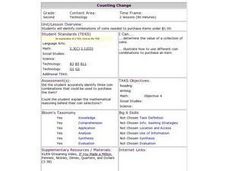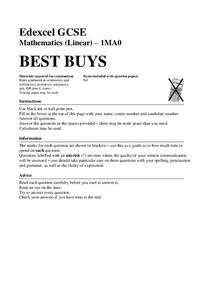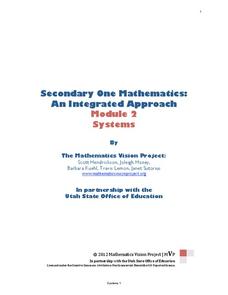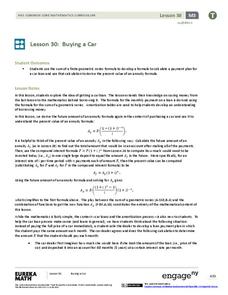Curated OER
Determining Mercantile Volume of a Pine Tree
Fourth graders, acting as foresters, determine timber volumes as sawtimber or pulpwood for marketing. They find the marketable value of a tree using its diameter and volume.
Curated OER
Magic Mirror Box
Young scholars observe a plywood box with mirrors. In this mirror and light lesson, students make informal, individual investigations with a plywood box that has been fitted with mirror squares. They use observation skills and...
Curated OER
Mineral Munch
Second graders explore the sodium content in foods they eat. After observing a table setting, 2nd graders then identify items made from rock. They taste low sodium crackers and compare them to regular crackers. Students discuss the...
Yummy Math
Movies ~ Oscars 2013
Using a popular topic, the movies, your class can meet a Common Core criterion. They compare box office movie returns, adjust older movies' incomes for inflation, and in this way use the four operations to solve real-world problems. This...
Curated OER
Math/Technology: Coin Combos
Second graders identify coin combinations needed to purchase items under a dollar. Using Kidspiration, they demonstrate three ways to purchase a pizza slice for 96 cents and choose an item which cost less than a dollar for other to...
Curated OER
Math Lesson: Just How Many is a "Million Dead"?
Learners are able to convert large numbers into meaningful ratios. They are able to conceptualize 1 million. Students grapple with the concept of a million. They use this activity to convey the idea of millions by converting war death...
Curated OER
A Guide to Financial Analysis
Knowing good project management means knowing how to conduct good financial analysis. Learner are introduced to the ins and outs of financial planning as it relates to cost, benefit, and project capital investment.
Mathed Up!
Best Buys
Which scenario is the better deal? Class members examine nine scenarios to determine which choice offers a better deal. Pupils decide whether they need to find unit costs or total prices to compare the two options.
Curated OER
Using Graphs
Print and use this useful unit on basic algebraic functions, domain, range, and graphing. Tasks include, illustrating simple functions with a graph, and identifying the domain and range of the function. This twelve-page packet contains...
EngageNY
More Examples of Functions
Discrete or not discrete? Individuals learn about the difference between discrete and non-discrete functions in the fourth installment of a 12-part module. They classify some examples of functions as being either discrete or non-discrete.
Curated OER
Breaking News English: Luxury Goods
In this luxury goods worksheet, students read the article, answer true and false questions, complete synonym matching, complete phrase matching, complete a gap fill, answer short answer questions, answer discussion questions, write, and...
Curated OER
7.RP Music Companies, Variation 2
Real-world multiple-step proportion problems are sometimes hard to find for your math class. Here is one designed specifically to meet that need. Learners use proportional relationships to determine price per share in the acquisition of...
Mathalicious
Pic Me!
Finally! Math and Instagram have come together to discuss the correlation between likes and followers. High schoolers can't help but want to discover what makes one account more popular than another by developing a line of best fit and...
Federal Reserve Bank
Creditors’ Criteria and Borrowers’ Rights and Responsibilities
Discover what criteria creditors use for making loans (the 3 Cs of Credit), and impress upon your young adults the rights and responsibilities related to using credit. Pupils role play as individuals seeking or providing credit, as...
EngageNY
Writing and Interpreting Inequality Statements Involving Rational Numbers
Statements often have multiple interpretations — but not these inequality statements. Scholars compare rational numbers and write inequality statements symbolically. The lesson includes problems that require comparing three numbers.
Mathematics Vision Project
Module 2: Systems of Equations and Inequalities
The brother-sister pair Carlos and Clarita need your class's help in developing their new pet sitting business. Through a variety of scenarios and concerns presented to the siblings, the learners thoroughly explore systems of equations...
Curated OER
Compounding with a 5% Interest Rate
The balance in an account continuously compounding interest is the context of this engaging task. Your young accountants will investigate the ending balance in an account as they compound the interest more and more. Learners write the...
CPM
Direct, Joint, and Inverse Variation
Here is a quick guide to direct, joint, and inverse variation used in realistic situations. Each topic has a page of notes and examples followed by practice problems. The resource explains each type of variation and provides their...
College Board
Random Variables vs. Algebraic Variables
Variables can vary in meaning. A reference material for AP® Statistics explains the difference between random and algebraic variables. It provides a hypothetical situation involving dice—great for use in a classroom situation.
Mathematics Vision Project
Module 3: Polynomial Functions
An informative module highlights eight polynomial concepts. Learners work with polynomial functions, expressions, and equations through graphing, simplifying, and solving.
Curated OER
Setting Goals: Finance
First, learners discuss the difference between short- and long-term goals, then they establish their own financial goals. They fill out a financial goal worksheet, create a long-term goal collage, and respond to a writing prompt defining...
EngageNY
Buying a Car
Future car owners use geometric sums to calculate payments for a car loan in the 31st installment of a 35-part module. These same concepts provide the basis for calculating annuity payments.
Curated OER
Stock Swaps, Variation 3
More on the fictitious takeover of the Apple Corporation by Microsoft. In this scenario, Microsoft has $28.00 per share to spare, so how many do they need to offer to make an even trade? This is an engaging problem to solve when...
Illustrative Mathematics
Walk-a-thon 1
Your mathematician's job is to explore the relationship between hours and miles walked during a walk-a-thon. The activity compels your learners to experiment with different means in finding out this proportional relationship. The answer...























